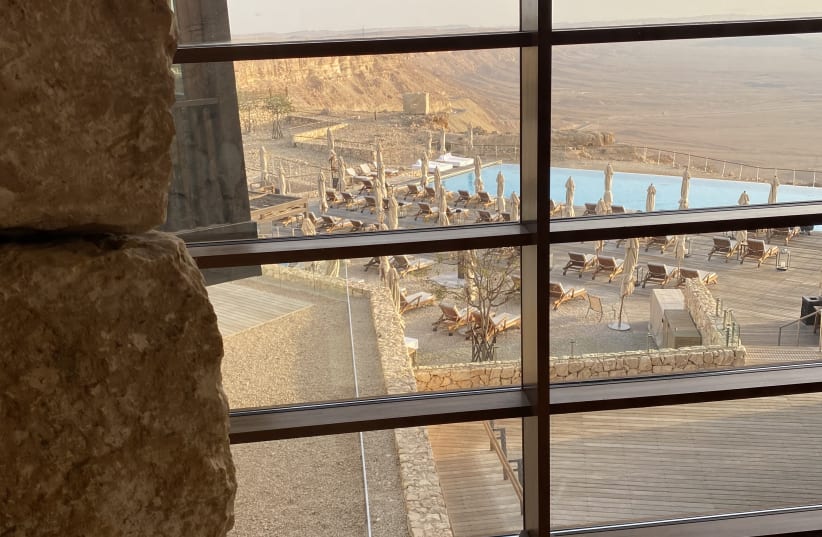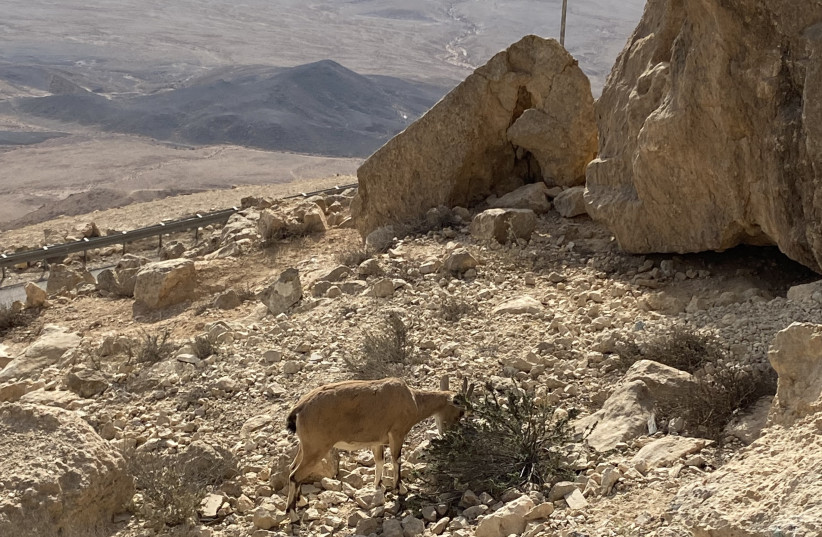It was my wife, Annie’s, big birthday. Long before corona, she had decided that she did not want a huge party. She wanted to spend a couple of nights at the luxury resort of Beresheet at Mitzpe Ramon overlooking the Ramon Crater (Makhtesh Ramon).
Mitzpe Ramon is a small town in the southern Negev desert established three years after the State of Israel was founded. It was originally set up to provide accommodation for the road workers who were building Highway 40. Within five years it had turned into a new development town with young families moving in from nearby Kibbutz Re’im.
Later, 180 housing units were built ready to accommodate new immigrants. They came from North Africa and Romania. In the 1960s more immigrants arrived from India. The town expanded further when an airbase was built there in the late Seventies. Today the population of Mitzpe Ramon stands at 5,211.
The Ramon Crater derives its name from scouts who explored the area in the 1940s. They first discovered a smaller crater and named it Makhtesh (Hebrew for mortar and pestle) because it resembled the forenamed object. In 1945, a second group of scouts among whom was the young Shimon Persky (who later changed his name to Peres) discovered the larger crater and named it Makhtesh Ramon after a geological feature found in the rocks of the crater.
The views from the town over the fissured landscape are spectacular. The crater was formed by the erosion of soil that formed a heart-shaped box canyon, 26 miles long and six miles wide. Hundreds of millions of years ago the Negev desert was covered by an ocean. As this sea began to recede, it left a hump-shaped hill which started to flatten due to the water and climatic conditions.
About five million years ago, the Arava Rift Valley was formed with rivers that changed their courses. In doing so, the soft rock on the inside of the valley was gradually carved out until it got deeper and deeper. Today the makhtesh (crater) is 1,500 feet deep with the deepest point at Ein Saharonim providing the only source of natural water.
This spring provides sustenance for the local wildlife including the onagers (wild donkeys) and ibex with their strange faces and bewitching yellow eyes. It was my third visit to the region. Journeying down from Jerusalem, one becomes aware of the changing terrain. From the moment you leave Jerusalem, you are traveling on the paths of our forefathers from Derech Avot (the road of the Patriarchs) to Beersheba where Abraham, Isaac and Jacob camped out.
Following on from there you then reach a more arid landscape until you come to Sde Boker where Israel’s legendary prime minister, David Ben-Gurion and his wife, Paula, lived.
Anyone who has visited the region cannot fail to be impressed and moved by the magnificent grandeur of the painted desert that lies in front of Sde Boker. The next leg of the journey along Highway 40 heralds even more impressive scenery, as the road begins to steepen and narrow descending toward Mitzpe Ramon.
The resort of Beresheet is one of Israel’s most luxurious vacation sites. Perched on the edge of a cliff overlooking the crater and the surrounding mountains, Beresheet is an incredible recreational experience. From the eco-friendly architectural design to the superb facilities, excellent service and cordon bleu style cooking, the resort lives up to its five-star reputation. What makes it even more unique is its surroundings. Every pathway, balcony and outdoor facility provides guests with a stunning view of the Negev. The indigenous ibexes wander freely through the premises as they do all over town, nibbling on grass and bushes and using some of the hotel’s swimming pools as a convenient watering hole.
Apart from the outstanding sports facilities that the hotel offers, there are plenty of things to do in Mitzpe Ramon including numerous desert excursions. One of the main reasons why my wife wanted to celebrate her birthday in the locale was because of the stargazing tour that she’d heard about from friends.
“They call him the Starman of Mitzpe Ramon,” she told me.
The individual concerned turned out to be a fellow by the name of Ira Machefsky, who made aliyah from Englewood, New Jersey, in 2009. Annie had exchanged WhatsApp messages with him and booked a night tour on the Wednesday of her birthday at 8:00 pm.
“We can only do the tour if the night sky is free of clouds, and so there’s no need to pay until we actually take the tour,” he reassured her. Because we were the only two people on the expedition that night, the “Starman” kindly agreed to pick us up from the hotel. I was keen to learn more about him and his work and so we invited him to join us for coffee.
The masked “Starman” duly arrived, looking like a character straight out of Spielberg’s Jurassic Park or E.T. The affable, avuncular short stocky fellow sat down in front of us and told us all about his amazing journey from Memphis, where he was born and raised, to his college days at Stanford and UC Berkeley.
“I began my career in the early days of IT in Palo Alto, where I worked for Digital Equipment Corps,” he told us. “My real passion from when I was a boy was astronomy.”
He explained how he was more or less self-taught, and many years later, together with his wife, Pam, they followed their daughter to Israel.
“We were the only olim (immigrants) ever to have moved directly to Mitzpe Ramon via Nefesh B’Nefesh,” he told us proudly. “My daughter had settled here and so my wife and I followed. It was the perfect place for me to devote the rest of my life to astronomy.”
He described how he built his tourist business. He began offering visitors a unique experience of viewing the night skies from the crater.
“The lack of light pollution in the crater makes the viewing of the stars and planets a very rare experience for anyone visiting these parts,” he said.
After telling us a great deal more about his fascinating life, Ira took us to his SUV where we climbed aboard. He drove us through the sleepy town and gave us a running commentary on its history and diverse population. We were on our way to collect his Israeli friend and fellow astronomer, Ze’ev. They had met at the local Chabad Synagogue (the only Ashkenazi synagogue in Mitzpe Ramon).
After collecting Ze’ev from his apartment, we headed out towards the bottom of the crater. It really was pitch dark, and I felt somewhat relieved that I had not elected to follow him in our own car. The winding steep road hugged the cliffs and we proceeded somewhat tortuously until the road straightened out a few kilometers away in the midst of the crater. We had been warned about the cold, and Ira’s joining instructions included advice about dressing warmly. As it turned out, our puffer jackets and scarves weren’t really needed in the unusually warm night air.
“You guys are really lucky,” he chortled. “It’s a perfect evening to do this and there’s not a cloud in the sky.”
There were no other vehicles to be seen anywhere, and the darkness felt palpable if not a little threatening. After a brief detour past an ancient gypsum mine and a small expanse of water, Ira followed a signpost off the main road that led us to a parking area that seemed as if it was in the middle of nowhere.
“This is where we get out.” He announced. Both men alighted, and as if following a well-rehearsed drill, began to take chairs and equipment out of the back of the vehicle. Annie and I gasped as we looked up at that night sky. I don’t believe that I have ever beheld such an incredible sight.
The millions of stars, luminous orbs and the thin crescent moon were perfectly visible to the naked eye. Ira soon had us sitting on our chairs, while Ze’ev set up the telescopes a few feet away. Even I was able to recognize the Milky Way and what looked like Orion’s Belt. For the next hour Ira regaled us with facts and stories about astronomy, the galaxy above the earth, some newly discovered stars, and more.
“What you are looking up at is the same sky that Avraham Avinu (our forefather Abraham) witnessed thousands of years ago.”
Annie and I were enraptured and enthralled as he used his green laser pointer to draw out the patterns and shapes of familiar constellations.
“As the night draws on the positions of the stars, constellations and planets become visible in different parts of the sky,” he told us as he pointed to the Northern Star. Directly above us was the constellation of Cassiopeia, the Queen of Aethiopia according to Greek mythology.
“Cassiopeia was one of the 48 constellations listed by the 2nd-century Greek astronomer Ptolemy,” he continued.
The piece de resistance came later when we got up and moved over to the telescopes where Ze’ev had positioned them so that we could catch our first-ever glimpse of two planets that were visible in the night sky. Ira and Ze’ev were like two excited teenage boys as they urged us forward to position our eyes over the telescope’s viewfinder. “Start with just one eye till you find it,” Ira coaxed.
Sure enough, each of us was able to see the circular beige sphere of the planet Jupiter with the distinctive amber marking of the great storm attached to its belly. Next came Saturn, an incredible sight. Not only were we able to see the planet’s famous rings, we were also able to find two of its 82 moons. All in all the stargazing experience remained the highlight of our trip to Mitzpe Ramon.
Having thanked Ira and Ze’ev, I remember thinking and saying to my wife, “After seeing all this and learning about the universe, I fail to see how anyone could not believe in God.”
As we drove back to the hotel in awestruck silence, my thoughts shifted to Israel’s national hero and first astronaut, Ilan Ramon.
The young fighter pilot spent much of his time at an airbase in the Negev not that far from the town and the crater.
Tragically, Ramon was killed in the Columbia Space shuttle that crashed in Palestine, Texas, on February 1, 2003. I thought about how he must have experienced his first sighting of the night sky above the crater. Could that have influenced the ex-fighter pilot’s decision to become an astronaut?
There are 24 places in the world and in space that are named after Ilan Ramon. However, I believe that the most fitting tribute to him is in Israel in the magical town of Mitzpe Ramon from where he took his name, and where the Ilan Ramon Museum and Memorial now stands. ■

